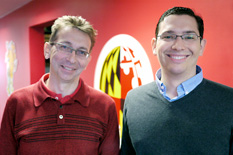News Story
WIFIRE Wins 3 HPCwire Awards at Int’l High Performance Computing Conference

University of Maryland Department of Fire Protection Engineering (FPE) professors Arnaud Trouvé (left) and Michael Gollner (right).
WIFIRE, the wildfire modeling system whose design team includes University of Maryland Department of Fire Protection Engineering (FPE) professors Michael Gollner and Arnaud Trouvé, received three of HPCwire’s annual Readers' and Editors' Choice Awards at the 2014 International Conference for High Performance Computing, Networking, Storage and Analysis.
Each year, HPCwire, which reports on the international high performance computing community, recognizes the most significant developments in the field in a variety of categories. WIFIRE received HPCwire’s Readers’ and Editors’ Choice Awards for the Best Application of Big Data, and its Editors’ Choice Award for Best Data-Intensive System.
Funded by a grant from the National Science Foundation, WIFIRE is a cyberinfrastructure that produces real-time and data-driven simulation, prediction and visualization of wildfire behavior. The project is part of the NSF Hazards SEES program, which supports research that enhances sustainability through the use of advanced technologies and new methods.
Launched late last year, WIFIRE is already cataloging and integrating data related to dynamic wildfire models from a variety of resources including sensors, satellites, and scientific models, and creating visual programming interfaces for using that data in scalable wildfire models. The system also enhances awareness and response by broadcasting information tailored for specific audiences, such as firefighters, emergency management staff, and the public. A video from the NSF’s Science Nation website featuring the project can be viewed online.
“This project is about integrating fire modeling and fire sensing technologies, and is aimed at reducing the large number of uncertainties associated with predicting fire behavior,” explains Trouvé. “We adapt data assimilation techniques that are commonly used in weather forecasting to wildland fire spread problems, which enables us to provide optimal solutions to tactical firefighting. WIFIRE is still young but it is extremely encouraging to receive the HPCwire awards. In my view it’s a recognition of both the sophistication of the project and the immediate connection it has with people.”
“Wildland fire is one of the most interdisciplinary problems we face today,” adds Gollner. “It’s wonderful that our early work has been recognized by the high performance computing community, whose members will surely play an integral role in developing and implementing the tools needed to address this problem in the future.”
WIFIRE is the result of collaboration among Gollner, Trouvé, and colleagues at the University of California, San Diego (UCSD), including the California Institute for Telecommunications and Information Technology, UCSD’s Department of Mechanical and Aerospace Engineering, and its Jacobs School of Engineering. Products based on the WIFIRE framework have been released to additional collaborators including the California Department of Forestry and Fire Protection, the U.S. Forest Service, and San Diego Gas & Electric. The WIFIRE team will hold its first workshop for dynamic-data driven wildfire modeling in January 2015.
Ultimately, WIFIRE will be available to government agencies, enabling them to save lives and property during wildfire events, test the effectiveness of response and evacuation scenarios before they occur, and assess the effectiveness of high-density sensor networks in improving fire and weather predictions.
Story adapted from the San Diego Supercomputer Center press release, courtesy of Jan Zverina (SDSC Communications).
For more information, and to learn more about how WIFIRE works, see:
“SDSC/UC San Diego Achieves a Hat Trick with 2014 HPCwire Awards”
FPE Research Highlight: “Data-Driven Wildfire Modeling”
wifire.ucsd.edu
Twitter: @WIFIREProject
NSF Award Abstract
Published November 24, 2014









